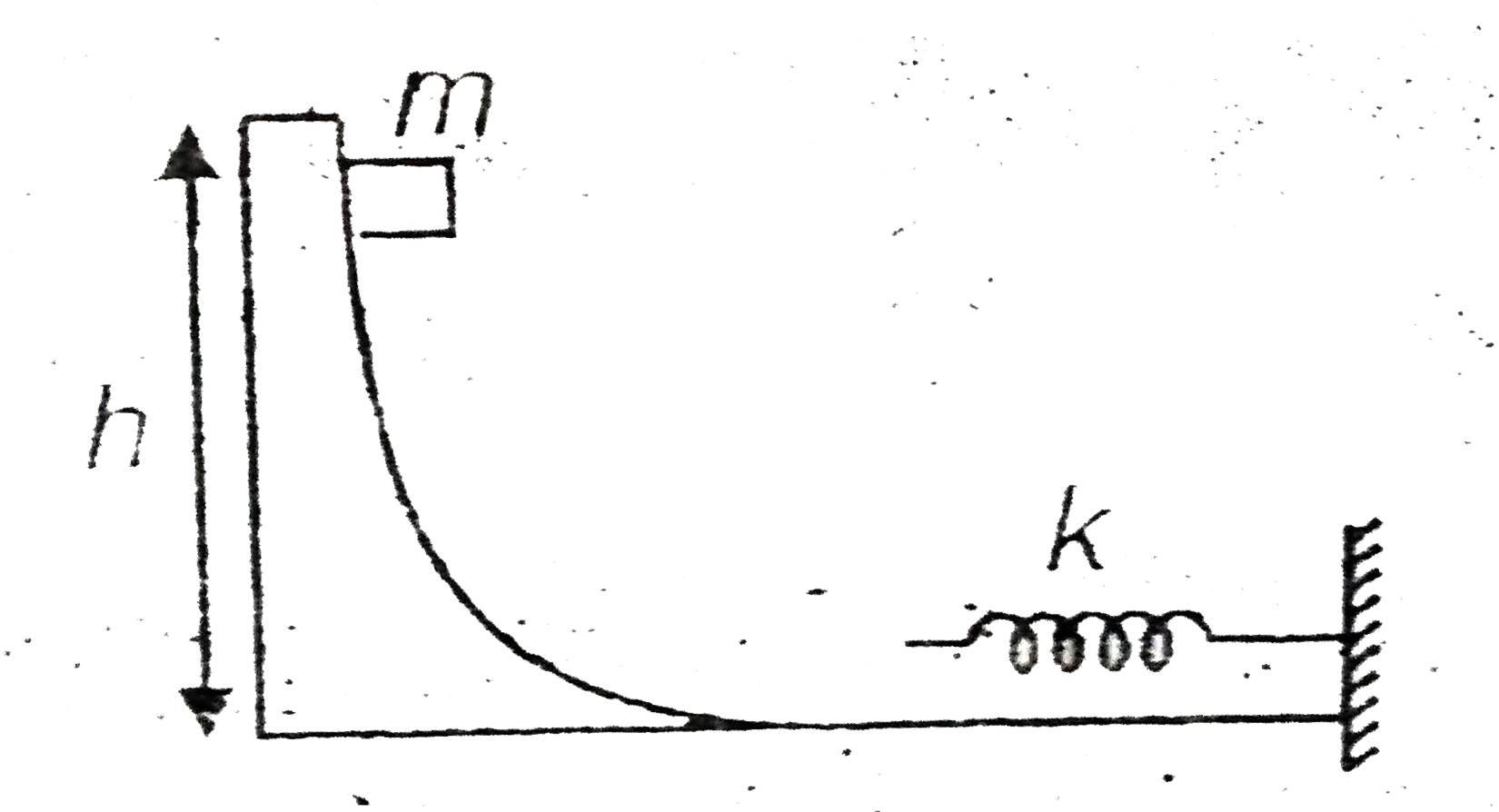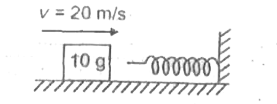Auto manufactures study the collision of cars with mounted spring of different spring constant. Consider a car of mass 1500 kg moving with a speed of 36kmh−1 on a smooth road and colliding with a horizontally mounted spring of spring constant 7.5×103Nm−1. Find the maximum compression of the spring .
To solve the problem of finding the maximum compression of the spring when a car collides with it, we can follow these steps:
Step 1: Convert the speed from km/h to m/s
The speed of the car is given as 36km/h. We need to convert this to meters per second (m/s) using the conversion factor 518.
V=36km/h×518=10m/s
Step 2: Calculate the kinetic energy (KE) of the car
The kinetic energy of the car can be calculated using the formula:
KE=12mv2
Where:
- m=1500kg (mass of the car)
- v=10m/s (speed of the car)
Substituting the values:
KE=12×1500kg×(10m/s)2=12×1500×100=75000J
Step 3: Set the kinetic energy equal to the potential energy (PE) of the spring
At maximum compression, the kinetic energy of the car is converted into the potential energy stored in the spring. The potential energy of the spring is given by:
PE=12kx2
Where:
- k=7.5×103N/m (spring constant)
- x is the maximum compression of the spring.
Setting KE equal to PE:
75000=12×(7.5×103)×x2
Step 4: Solve for x2
Rearranging the equation to solve for x2:
75000=12×7.5×103×x2
Multiplying both sides by 2:
150000=7.5×103×x2
Now, divide both sides by 7.5×103:
x2=1500007.5×103
Calculating the right side:
x2=1500007500=20
Step 5: Calculate x (maximum compression)
Taking the square root of both sides:
x=√20≈4.47m
Final Answer
The maximum compression of the spring is approximately 4.47m.
---
The speed of the car is given as 36km/h. We need to convert this to meters per second (m/s) using the conversion factor 518.
The kinetic energy of the car can be calculated using the formula:
- m=1500kg (mass of the car)
- v=10m/s (speed of the car)
At maximum compression, the kinetic energy of the car is converted into the potential energy stored in the spring. The potential energy of the spring is given by:
- k=7.5×103N/m (spring constant)
- x is the maximum compression of the spring.
Rearranging the equation to solve for x2:
Taking the square root of both sides:
The maximum compression of the spring is approximately 4.47m.
Topper's Solved these Questions
- BOOK - DC PANDEY ENGLISHCHAPTER - WORK, ENERGY AND POWEREXERCISE - CHECK POINT 6.120videos
WORK, ENERGY AND POWER
- BOOK - DC PANDEY ENGLISHCHAPTER - WORK, ENERGY AND POWEREXERCISE - CHECK POINT 6.220videos
WORK, ENERGY AND POWER
- BOOK - DC PANDEY ENGLISHCHAPTER - WORK, ENERGY & POWEREXERCISE - Level 2 Comprehension Based2videos
WORK, ENERGY & POWER
- BOOK - DC PANDEY ENGLISHCHAPTER - WORK, POWER AND ENERGYEXERCISE - E Integer Type Questions11videos
WORK, POWER AND ENERGY
Similar Questions
To stimulat car accidents, the auto manufacturers study the collisions of moving cars with mounted springs of different spring constants. Consider a typical simulation with a car of mass 1000kg moving with a speed of 18.0km/h on a smooth road and colliding with a horizontally mounted spring of spring constant 6.25×103Nm−1. What is the maximum compression of the spring?
View SolutionA body of mass 5 kg moving with a speed of 1.5 m/s on a horizontal smooth surface collides with a nearly weightless spring of force constant k = 5 N/m. The maximum compression of the spring would be
 View Solution
View Solution
Knowledge Check
- Question 1 - Select One
A car of mass 1000 kg moving with a speed 18kmh−1 on a smooth road and colliding with a horizontally mounted spring of spring constant 6.25×103Nm−1. The maximum compression of the spring is
A1 mB2 mC3 mD4 m
A mass of 0.5kg moving with a speed of 1.5m/s on a horizontal smooth surface, collides with a nearly weightless spring of force constant k=50N/m The maximum compression of the spring would be.
View SolutionA solid cylinder of mass 3kg is rolling on a horizontal surface with velocity 4ms−1. It collides with a horizontal spring of force constant 200Nm−1. The maximum compression produced in the spring will be :
View SolutionA block of mass m moving with velocity v0 on a smooth horizontal surface hits the spring of constant k as shown. The maximum compression in spring is
 View Solution
View SolutionEach of the blocks shown in figure has mass 1 kg. The rear block moves with a speed of 2 m/s towards the front block kept at rest. The spring attached to the front block islight and has a spring constant 50 N/m. find the maximum compression of the spring.
 View Solution
View SolutionA block of mass m is released from a height h from the top of a smooth surface. There is an ideal spring of spring constant k at the bottom of the track. Find the maximum compression in the spring (Wedge is fixed)
 View Solution
View SolutionTwo blocks of mass 2kg and 5kg are given speed as shown in the figure. System is lying on a frictionless surface and the blocks are connected by a massless spring if spring constant 35Nm. Find the maximum compression in the spring.
 View Solution
View SolutionA block of 10 g slides on smooth horizontal surface with 20 m/s towards a spring of spring constant 100 N/m placed horizontally (as shown in figure). The maximum compression in spring is
 View Solution
View Solution

